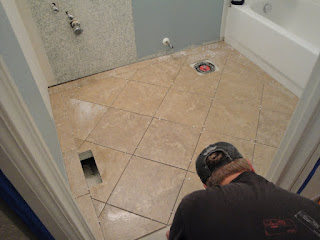Okay, as I see them we have a lot of smaller jobs (cleaning, painting, pulling baseboards, etc) that don't require me to learn any new skills or anything. We also have some big jobs (laying wood floors, tile, renovating a bathroom, putting in baseboards) that will require me to learn some new skills. These are jobs that will take longer, probably require some research and guidance and for some of them will require us to enlist the services of a licensed professional. We hadn't done any of these jobs until now. We'd been working for three weeks doing mainly the simpler things. We pulled wires, painted, changed some valves and stuff (the spigot was definitely a "big" job in spirit, but took such a short time I don't really count it) and mostly did routine maintenance sorts of things to the house. Not to say they weren't important, just that they weren't the things that I was thinking of as being the big projects. Unfortunately, every single room in the house requires a biog project to finish it because we're replacing the floor and the baseboards in every room. We were making progress, but we could only get to a point.
That all changed this weekend. We finally put down a new floor in the hall bathroom upstairs. This is important because that's going to be our primary bathroom for a while. We're completely re-doing the master bath and can't move into the master bedroom until that's finished so we're living on the main floor and using the hall bath shower for the time being. Not ideal, but you do what you have to do. Getting the hall bath 100% complete (or at least very close to it) before we move in was a big priority and the tile was the biggest step there.
Now, for pictures and explanation.
My friend Erick is helping me with this project. He and his wife Kristen are friends of mine from high school and we ended up moving just down the street from them. They've done a lot of really amazing work on their house and we asked them if they'd be willing to help us with the tile in here. They did their bathroom and it looks really amazing, so we were hoping we could take advantage of their experience. Here, we're working on the layout. We were originally just going to do a standard tile pattern with no border but once we tried laying the tiles diagonally Jenna was hooked. I have to admit, it looked really good from the beginning and I didn't really want to go back to the other either.
Here's what we did. We actually cut and fit all of the pieces together with spacers before we put down any mortar. It was nice because the actual process of laying the tile took a relatively short time. Erick and Kristen has previously cut and laid tiles simultaneously, so they could fit the tile perfectly next to the others as they ended up. That way also makes a lot of sense, for sure. The way that we heard on the DVD we've watched the most is the one I think we'll do in the future. In that method, you lay everything out with chalk lines on the backer board first, then set all of your uncut field tiles. You let that cure for 24-48 hours, then you go around and cut and set all the edge tiles. This is sort of the best of both of the previous methods. You get a really nice layout and have it rock solid on the floor, then you can custom cut all the edge pieces to fit perfectly based on the middle tiles. It will take a few extra days to finish, but I think it will be worth it.
Here's our tile saw setup. The saw is Martin's (the man has all the best tools) and we set it up on the patio. This is probably where you want to set yours up, if possible. The process is very dusty and will coat anything around it in fine particles of tile. You don't want to do it indoors and you only want to do it in the garage if you can tape or staple a drop cloth behind the saw to catch the spatter. We're using the tile saw style called a "bridge" instead of a "tub" saw. Here's what that means. A tile saw is a diamond blade spinning very quickly. It's not like a regular toothed blade, it's actually abrading through the tile more than it's cutting. That abrasion causes a lot of heat so you need water to cool down the blade and keep it from burning out. A tub saw has the saw mounted into a tabletop like a table saw. The bottom of the blade runs through the water in the tub and cools itself down. The bridge saw has the blade up top with a pump to pump water onto the blade while it's spinning. The tub underneath catches the water and the tile bits. Both styles will get you a messy tub of water, and gunky water will clog your blade eventually. What we did here is to put the pump into a bucket of clean water and just bail out the tub periodically. This way the water on the saw blade is always cold and always clean. It worked really well for us and the saw never gunked up or anything.
Men at work.
All the pieces laid in with the spacers. The issue we encountered with this method is that your starter pieces have to be in exactly the same place when you mortar them as when they were laid dry, otherwise things start getting a little loose. This is the main issue I see with this way of doing the tile and there are a few ways around it, but we didn't use any of them.
The other important thing when cutting everything first is that all the pieces have to be kept in the same place in relation to each other. We laid these out on the floor in the same way they were in the bathroom and then just pulled them out of here and laid them down. It worked pretty well, I think. Way easier than labeling them all, for sure.
Erick is enjoying some pink King Soopers cookies. They are the single greatest baked good of all time, in my humble but accurate opinion.
Kristen is mixing up the mortar. We're ready to lay the tile! We had actually used a power drill with a paddle bit on it to mix the majority of the mortar, but we stirred in a little more powder once we got it up here. The consistency you want is like peanut butter. We had gone to milkshake consistency with the stuff we put under the backer board so it would fill gaps, but for this you want it really thick. My cordless drill is a 14.4 volt thing that normally rocks the house. We have a corded drill we were using for this and it was getting really hot and smelling like burning. We're very lucky Erick brought his monstrous 19.2 volt cordless Craftsman drill to mix up the last part of this. It has a low setting that drains the battery quickly but busts out the same kind of torque normally reserved for trucks. It was ideal for this application and way easier than trying to mix by hand.
Kristen is doing something here called "back-buttering." Sounds dirty, but it just means you're putting the mortar on the back of the tile instead of the floor. It works well for small pieces or pieces that are too small for the trowel to fit inthe the space on the floor.
Getting all the pieces set in along the tub. The edge of the tub isn't straight which made this a tough thing to do.
Based on the hairiness of the arm, you can tell that I have taken over the tiling at this point. Something that kept nearly tripping me up is not spreading the mortar far enough. I would get it almost far enough to cover the whole tile, but not quite. Make sure you have plenty of mortar under each tile or you could end up with weak spots. Something else we used was a flathead screwdriver to clean out extra mortar from the gaps. You want to leave those gaps pretty clean so the grout can go and stick in there. We're only doing 1/8" grout lines so a screwdriver is just about perfect.
All done! We're going to let it set for two full days. The mortar says you can walk on it after 16-24 hours but we're going to be extra safe. We'll be grouting tonight and I'll get plenty of pictures of that, too. Woot!
Monday, May 3, 2010
Subscribe to:
Post Comments (Atom)













Are you going to seal it after you put in the grout?
ReplyDeleteThe tile's porcelain so it doesn't need to be sealed. We're also using a new grout additive that should mean we don't need to seal the grout, either. Woo-hoo for low maintenance flooring!
ReplyDeleteYou know I'm glad i got that hair cut.
ReplyDelete